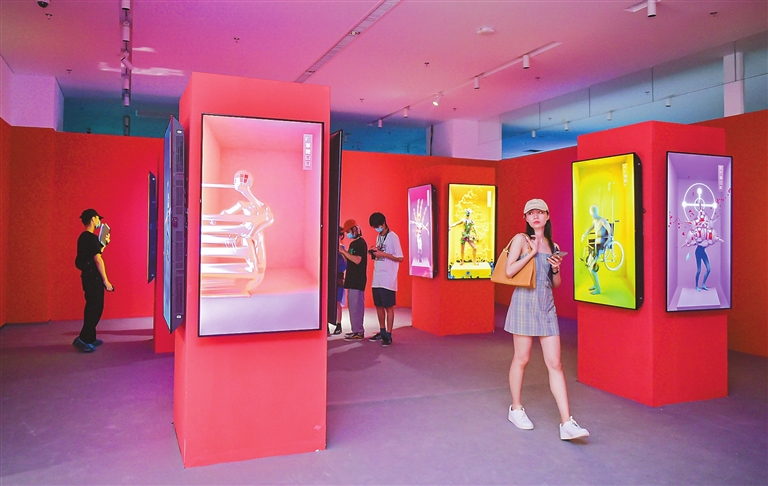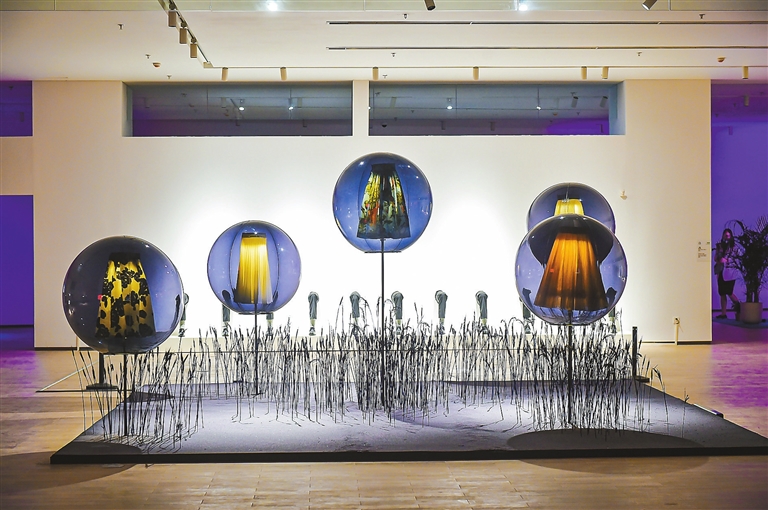

Cao Zhen caozhen0806@126.com AS Shenzhen’s Guangming District has been chosen for the next stage of the city’s scientific development, and the Guangming Science City is expected to become a world-class science center by 2025, a new art exhibition related to futurology echoes the district’s mission. Titled “Futurology of Art,” the exhibition at the Art Gallery of the Guangming Culture and Art Center features installations by 27 Chinese artists in a variety of media, such as 3-D animation, robotics, laser and physics. The exhibition is divided into three sections: “Space and Humans,” “Post-Human Myths” and “Human-Machine Integration.” “The three parts are in line with the three major domains and trends of new media art,” said Zhang Haitao, curator of the exhibition. He added that new media art dealing with the future is derived from contemporary art, but future-oriented art highlights an unfamiliar and uncertain world and contemporary art pays attention to what has happened and what is happening. There are some inspiring examples of futurology artworks from both established and emerging artists on display at the exhibition. Artist Liu Shuming’s installation “Listening From Another Dimension” is interesting. She collected the breathing sounds from women of different ages. Every time a woman’s sound is played, a skirt inside a big glass ball installation is blown by wind. The work visualizes the movement of and tension in life. Tian Xiaolei’s multi-screen video installation “Myth” is an ongoing project he started in 2018. In each screen of the video, there’s a human implanted with machines dancing against a backdrop of a strong dazzling color. The artist assumes that the special human beings are the experimental specimens in the future when we will become more bio-diversified and have more choices in deciding our own path of evolution through the implanting of gadgets. Tian said he is interested in the uncertainty of the rapid iteration in this era, the relationship between life, science and technology, and the new species produced by the hybrid age. Visitors may remember their childhood memories which are overlaid on projected images from artist Zheng Hongchang’s installation “The Accordion 1-5.” Figurines fabricated by a 3-D printer are integrated into an accordion’s bass part, a creation the artist dreamt of as a child. Their shadows are projected onto the walls and move like a toy. “These seemingly unrelated objects are connected as one when they are projected on the wall. It’s like the things in our life: Unrelated things are interrelated when you look backward,” said Zheng. Miao Xiaochun’s “Gyro Dance” video features an agglomerate of a digital figure’s motions at a manic speed. All the figures in Miao’s digital art creations are identical bald and naked men whose face images are derived from a 3-D model of Miao himself. These figures are a presentation of the anonymous public and the unknown identity of the artist. It conveys the confusion of the artist towards himself, the existence of body, the presence of thoughts, the material world and the society. “It seemingly implies that I stay alive because of the ceaseless movements,” Miao said about “Gyro Dance.” “Despite the ongoing high-tech revolution, the core of human expectation for the future still lies in eternal dignity and happiness. The trends of futurology art focus on humans’ efforts to cope with the looming survival crises and expressing their evolving understanding of existence,” said curator Zhang. Opened Sept. 19, the Guangming Culture and Art Center also has a concert hall, a theater, a library and an urban-planning exhibition hall. Covering 38,000 square meters and with a floor area of 130,000 square meters, the center is the largest multifunctional cultural venue in north Shenzhen. After the opening concert was held Saturday night, conductor Li Xincao, coloratura soprano Wu Bixia and tenor Shi Yijie were recognized as the center’s honorary artistic advisers. As part of the center’s talent support, artist residency and youth development plans, young dancer Hu Shenyuan has launched his studio at the center and a children’s choir is recruiting members. Dates: Until Dec. 15 Hours: 10 a.m.-6 p.m. Venue: Art Gallery of Guangming Culture and Art Center, Guanguang Road, Guangming District (光明区观光路光明文化艺术中心美术馆) Metro: Line 6 to Fenghuang Town Station (凤凰城站), Exit B | 
